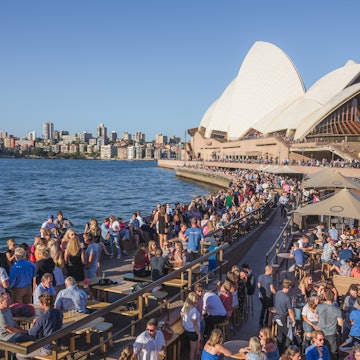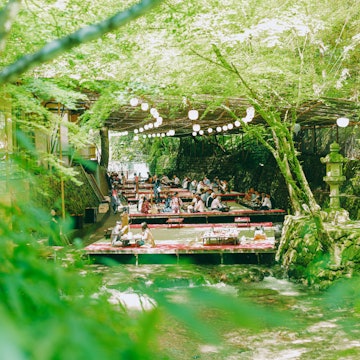
Adventurous spirits: the best places to sample the world’s most unusual alcohols

May 9, 2019 • 6 min read

Are you sick of whisky sours? Tired of gin and tonics? Left nauseous by the thought of vodka served neat? Well then it’s time you found yourself a new staple, something that sounds exotic and sexy and screams effortless sophistication when bellowed into a bartender’s ear – perhaps something with crushed insects in it?
So forget Ireland’s whiskey scene and New York’s miscellany of mattress factories turned artisan gin joints, and embark on a quest to find a new favourite tipple at one of these quirky bars and distilleries specialising in lesser-known spirits from around the world.
Find more of the world’s great distilleries and bars in Lonely Planet’s Global Distillery Tour.

Quaff arak in a swanky Beirut bar
In the middle of Beirut’s frenetic nightlife scene sits Anise, a cool cocktail bar resembling a James Bond movie, with suave white-jacketed barmen serving Hemingway Martinis. But Anise is also dedicated to Lebanon’s national drink, arak – a clear alcohol made from distilled wine and green aniseed, which is aged in stone amphoras and, when served, turns milky white as water is added.
Although there are some industrial producers, arak is essentially a home-brew tradition, and Anise owner Hisham Al Housein scours the mountains and valleys of Lebanon buying up small-batch gallon jars, made from village farmers who grow their own grapes, distilling with handmade copper contraptions modelled on medieval alembics. There are always six hand-crafted araks on Anise’s drinks list, identified by the name of the village, while the producer and indigenous grape variety is kept secret.
What to try: Arak, neat. As Hisham explains: ‘We only serve arak neat, the real way to appreciate it, as it has always been drunk by our elders.’

Swig some singani in southern Bolivia
One of Bolivia’s best-kept secrets is its one-of-a-kind national tipple singani, an unaged spirit distilled from aromatic white Muscat of Alexandria grapes. Casa Real is one of the powerhouse producers of singani, set in the year-round, springlike climate of the Santa Ana Valley at the heart of Tarija’s Ruta del Vino in Bolivia’s deep south.
Director of production and oenologist Jorge Furió is at pains to point out that there’s nothing like singani anywhere else in the world. The spirit’s distinctive floral nose is down to a combination of terroir and production method and, unlike Peruvian pisco, it’s made from just one grape. Inside the distillery you’ll see Cognac-style alembic stills where Don Lucho and Singani 63 are made – the latter beverage co-created by film director Steven Soderbergh, who became enamoured by the flavour of singani while filming the blockbuster Che in the country.
What to try: The double-distilled black-label Gran Singani with lime and ginger ale in a Chuflay cocktail.

Shot some fiery genièvre in Ghent
‘T Dreupelkot, Ghent’s most famous watering hole, sits on a picturesque river bank in the historic centre, with a dark, cosy salon packed to bursting from sunset to the early hours. The bar is dedicated to Belgium’s national drink: genièvre for French-speakers, or jenever in Flemish – the precursor of modern gin. This aromatic alcohol, initially distilled from wheat or barley mash, is distilled again with juniper berries and other botanicals.
It is said to have been accidentally discovered in 1303 by a Brussels alchemist searching for gold. The Dutch then commercialised it to the world, and England demonised it as ‘Mother’s Ruin’. There is a daunting list of 215 to choose from here, including traditional stone bottles of 10-year-aged genièvre, as highly prized as single malt. The genial owner, Pol, holds court behind a minuscule bar as he has for 33 years, performing the Dreupelkot ritual of lining up tiny shot glasses, filling them to the brim, and waiting for customers to bow their heads and take a little sip before raising the glass.
What to try: Any serious drinker should try a glass of Pol’s fiery red pepper genièvre.

Brave an authentic jar of moonshine in Tennessee
If you take away the bad boy reputation, moonshine is nothing more than un-aged whiskey, often sourced from corn. But where’s the fun in that? A wonderful spot to knock back a glass and get into the spirit (literally) is ‘The Holler’, the nickname for Ole Smoky Moonshine Distillery in downtown Gatlinburg, where musicians play bluegrass on the patio and the liquor comes in mason jars.
Passels of different flavoured hooch cost $5 and if you ask, staff might also give an impromptu tour. Ole Smoky was the first distillery to open in Tennessee after a law was passed in 2009 allowing commercial distilling in 41 counties (from only three). Founder Joe Baker is a Gatlinburg native whose ancestors were living in East Tennessee before it even became a state in 1796. Pre-2009, some of Joe’s relatives made illegal whiskey and he can recall seeing stills and helping to make grain mash growing up. ‘I have a certain sense of pride coming from the mountains and those traditions,’ he says.
What to try: Nothing could be more quintessentially American than a sip of Joe’s tasty Apple Pie hooch.

Treat your taste buds to a tangy tuak cocktail in Kuching
Travel upriver to the world’s oldest rainforests in Borneo’s Sarawak and the traditional drink in a tribal Long House will be tuak, a heady moonshine brew of fermented glutinous rice. But in the urbanised environment of Sarawak’s capital Kuching, it can also be sampled in very different circumstances in The Ranee, a chic boutique hotel fashioned out of two 19th-century shop houses.
Light wine tuak can be sampled in The Ranee’s popular bistro, but the serious distilled tuak, known as langkau, is left in the hands of the mixologist of the hotel’s MBar, where the clear distilled spirit is whipped up with various fruits to form half a dozen exotic cocktails, with appetising names like Orang Utan Swing, which mixes the potent alcohol with tangy tropical fruits.
What to try: Adventurous drinkers should order the Borneo Black Magic, which blends the jungle spirit with Guinness.

Up the ant-e with a unique gin in Southern Australia
Adelaide Hills Distillery is known for its ground-breaking Australian Green Ant Gin, using real insects in its distilling process. Green ants have long been foraged by Aboriginal Australian communities for medicinal benefits but it’s their lime flavour that’s key to this gin. The distillery sources the ants from a Northern Territory bush tucker farm and each bottle displays a permit number to reflect the sustainable harvest of the namesake ingredient.
Native ingredients feature heavily in the distillery’s other offerings, too. The quandong, or Australian wild peach, is critical to Adelaide Hills’ award-winning Bitter Orange aperitif and strawberry gum is credited for providing the summery twist evident in the distillery’s pink drink – the 78° Sunset Gin. Set in the lush patchwork of farms, vineyards and bushland of the Adelaide Hills region, an extra bonus for visitors is that the distillery tasting room sits in the same grounds as Mismatch Brewing Company and The Hills Cider Company. Expect tasting flights from the trio of businesses, as well as access to a large viewing platform so visitors can observe the still and brewhouse.
What to try: It has to be the Australian Green Ant Gin, or a 78° Sunset Gin for the more squeamish.
https://shop.lonelyplanet.com/products/lonely-planets-global-distillery-tour-1













